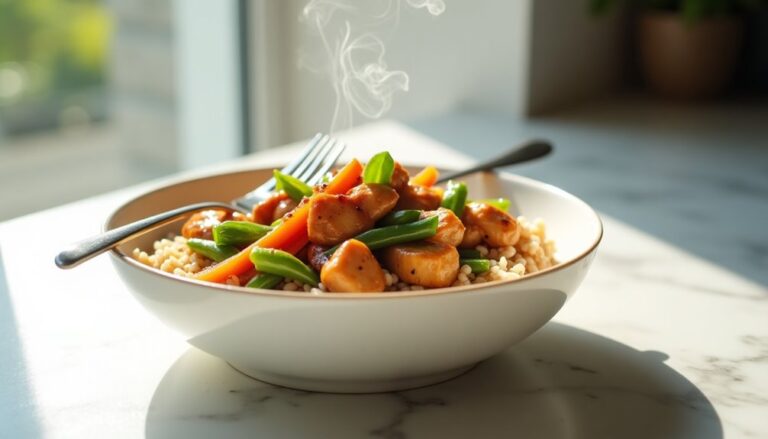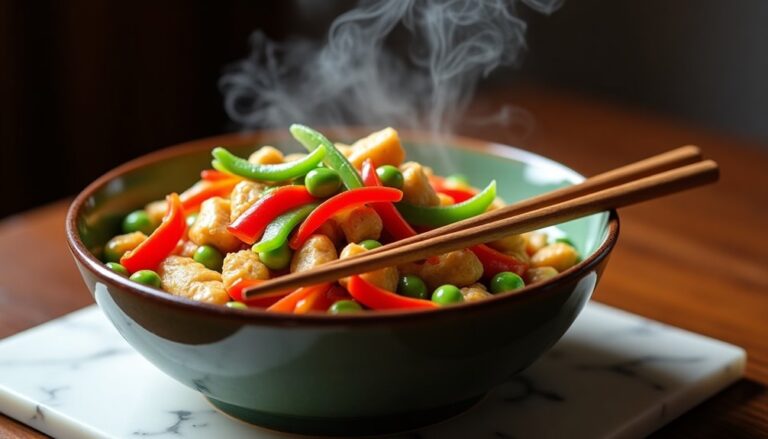8 Easy Hibachi Recipes
You've probably enjoyed the sizzling excitement of hibachi restaurants, where skilled chefs create mouthwatering dishes right before your eyes. Now you can bring those same authentic flavors and techniques into your own kitchen with these eight approachable recipes. From perfectly seared chicken to that legendary yum yum sauce, you'll master the essential elements of teppanyaki cooking. Let's explore how to recreate your favorite Japanese steakhouse dishes, starting with the most important ingredient: proper heat control.
Classic Hibachi Chicken

Classic Hibachi Chicken represents the perfect blend of Japanese steakhouse flavors brought to your home kitchen. This restaurant-style dish combines tender chicken pieces with a savory mix of soy sauce, butter, and garlic, creating that distinctive hibachi taste that's both comforting and exotic.
While traditional hibachi requires a special flat-top grill, this adapted version allows you to achieve similar results using a large skillet or flat griddle. The key lies in getting the proper high heat sear on the chicken while maintaining its juicy interior, complemented by the signature hibachi cooking sauce.
- 2 pounds boneless, skinless chicken breasts, cut into 1-inch cubes
- 4 tablespoons soy sauce
- 3 tablespoons butter
- 2 tablespoons sesame oil
- 4 cloves garlic, minced
- 1 tablespoon ginger, minced
- 1 medium onion, diced
- 2 carrots, julienned
- 1 zucchini, sliced
- Salt and pepper to taste
- 1 tablespoon sesame seeds
- 2 green onions, chopped
Heat a large skillet or flat griddle over medium-high heat. Add sesame oil and 1 tablespoon butter, allowing it to melt completely. Season chicken with salt and pepper, then add to the hot pan in a single layer. Cook for 4-5 minutes until golden brown, then flip and cook an additional 3-4 minutes. Remove chicken and set aside.
In the same pan, add remaining butter, garlic, and ginger. Add vegetables and stir-fry for 3-4 minutes until tender-crisp. Return chicken to the pan, add soy sauce, and toss everything together until well combined and heated through. Garnish with sesame seeds and green onions before serving.
For best results, ensure your pan is properly heated before adding any ingredients, as this helps achieve the characteristic hibachi sear. Also, avoid overcrowding the pan – cook in batches if necessary, as too much food in the pan will create steam instead of the desired sear. The chicken should be patted dry before cooking to achieve better browning, and all ingredients should be prepped in advance as the cooking process moves quickly once started.
Grilled Hibachi Shrimp
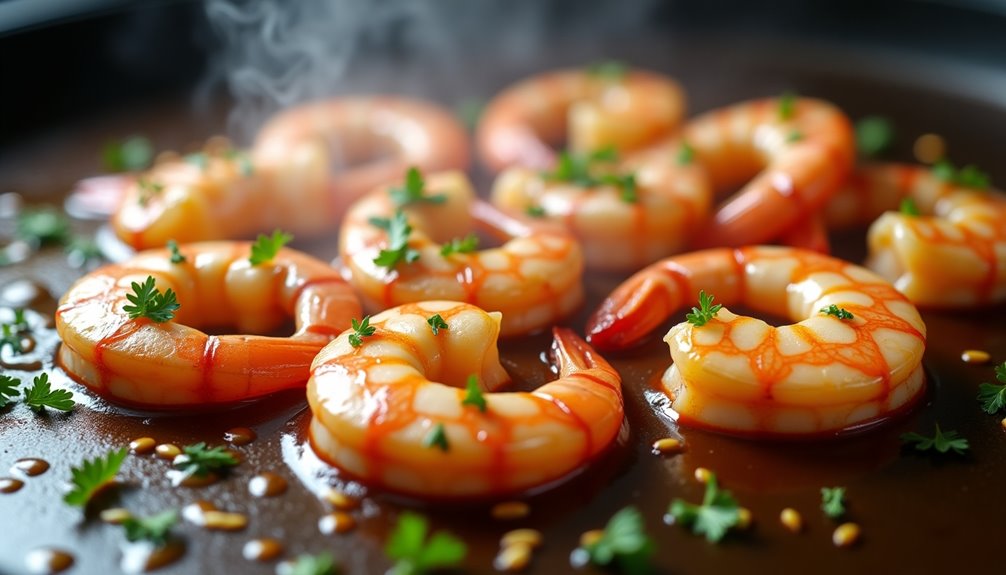
Hibachi-style grilled shrimp captures the essence of Japanese teppanyaki cooking, bringing restaurant-quality flavors to your home kitchen. This quick-cooking seafood dish combines succulent shrimp with a savory blend of soy sauce, butter, and garlic, creating that distinctive hibachi taste that's both satisfying and memorable.
The key to achieving the perfect hibachi shrimp lies in the preparation and timing. While traditional hibachi restaurants use a flat top grill, this recipe adapts the technique for home cooking using a large skillet or griddle, making it accessible while maintaining the authentic flavors and textures that make hibachi shrimp so popular.
- 1 pound large shrimp (16-20 count), peeled and deveined
- 3 tablespoons soy sauce
- 2 tablespoons butter
- 2 tablespoons vegetable oil
- 4 cloves garlic, minced
- 1 tablespoon lemon juice
- 1 teaspoon sesame oil
- 1/2 teaspoon ground black pepper
- 1/4 teaspoon salt
- 2 tablespoons fresh parsley, chopped
Heat a large skillet or griddle over medium-high heat until very hot. Pat the shrimp dry with paper towels and season with salt and pepper. Add vegetable oil to the hot surface and arrange the shrimp in a single layer, ensuring they don't overlap. Cook for 2-3 minutes on each side until they turn pink and develop a light char.
Reduce heat to medium and add butter, garlic, and soy sauce to the pan. Let the butter melt and combine with the soy sauce, then toss the shrimp to coat them evenly in the sauce. Add lemon juice and sesame oil, giving everything a final toss. Remove from heat and garnish with fresh parsley before serving.
For best results, ensure your cooking surface is properly preheated before adding the shrimp. Overcrowding the pan will cause the shrimp to steam rather than sear, so cook in batches if necessary. The shrimp should be completely thawed and dried before cooking to achieve the proper sear, and be careful not to overcook them as they can become tough and rubbery.
Hibachi Steak and Mushrooms

Hibachi-style cooking brings the exciting flavors of Japanese steakhouse cuisine right to your home kitchen. This combination of tender steak and savory mushrooms creates a perfect harmony of textures and tastes that captures the essence of traditional hibachi cooking.
The key to achieving authentic hibachi results lies in using high heat and the right seasoning combination. While restaurants use special flat-top grills, you can recreate similar results using a large skillet or flat griddle pan, making this dish accessible for home cooks.
- 1 pound ribeye steak, cut into 1-inch cubes
- 8 ounces button mushrooms, quartered
- 3 tablespoons soy sauce
- 2 tablespoons butter
- 2 tablespoons vegetable oil
- 2 cloves garlic, minced
- 1 teaspoon sesame oil
- 1 teaspoon black pepper
- ½ teaspoon salt
- 2 tablespoons green onions, chopped
Heat your skillet or griddle over high heat until it's very hot. Add vegetable oil and let it heat until shimmering. Place the steak cubes in a single layer and cook for 2-3 minutes without moving them to achieve a good sear. Flip and cook for another 2 minutes for medium-rare. Remove the steak and set aside.
In the same pan, add butter and mushrooms. Cook for 4-5 minutes until golden brown, then add garlic, soy sauce, and sesame oil. Return the steak to the pan and toss everything together for 1-2 minutes. Season with salt and pepper, and garnish with green onions before serving.
For best results, ensure your steak is at room temperature before cooking and pat it dry with paper towels to achieve better browning. Don't overcrowd the pan, as this will cause the meat to steam rather than sear. If needed, cook in batches to maintain the high heat necessary for authentic hibachi results.
Homemade Yum Yum Sauce

A beloved companion to any hibachi dish, Yum Yum Sauce is that creamy, tangy, and slightly sweet condiment that has become synonymous with Japanese steakhouse dining. This pink-hued sauce adds a rich, flavorful dimension to grilled meats, seafood, and vegetables, making it an essential element of the hibachi experience.
While many restaurants closely guard their specific recipes, this homemade version captures the essential flavors and texture that make Yum Yum Sauce so irresistible. The combination of mayonnaise, butter, and select seasonings creates that signature taste that keeps diners coming back for more.
In a medium bowl, combine the mayonnaise and melted butter, whisking until smooth. Add the sugar, paprika, garlic powder, onion powder, and cayenne pepper if using. Mix thoroughly until all ingredients are well incorporated. Add the tomato paste and rice vinegar, continuing to whisk until the sauce takes on a uniform pink color.
Gradually add water, one tablespoon at a time, until you achieve your desired consistency. The sauce should be smooth and easily spreadable but not too thin. For best results, transfer the mixture to an airtight container and refrigerate for at least 6 hours or overnight to allow the flavors to meld together.
For optimal results, bring the sauce to room temperature before serving. The sauce can be stored in the refrigerator for up to two weeks. If the sauce becomes too thick after refrigeration, simply whisk in a small amount of water to restore the desired consistency. Avoid using low-fat mayonnaise as it can affect the texture and flavor of the final product.
Hibachi Fried Rice
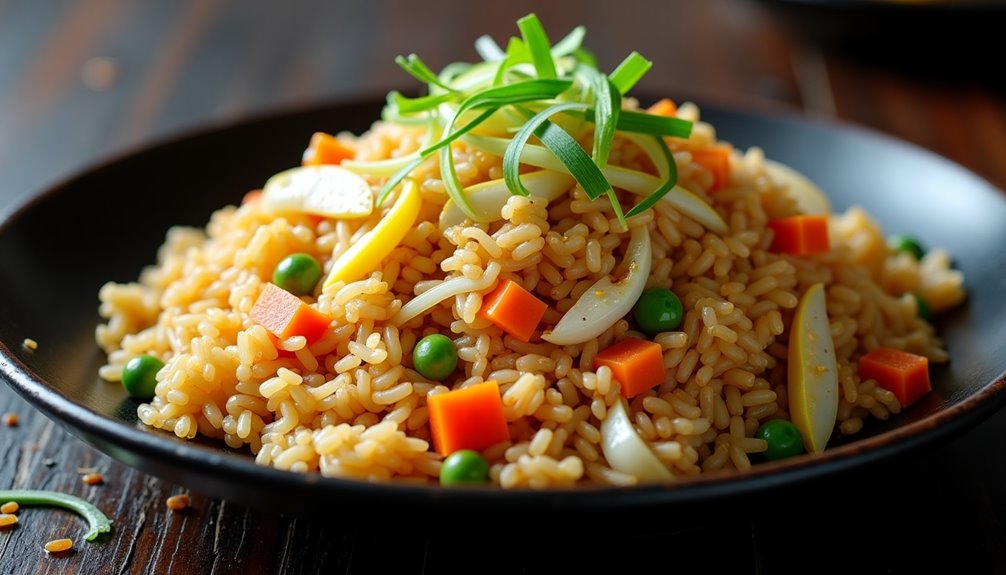
Hibachi fried rice is a beloved Japanese steakhouse classic that brings restaurant-quality flavors to your home kitchen. This savory dish combines perfectly cooked rice with vegetables, eggs, and a signature blend of seasonings that create that distinctive hibachi taste.
While traditional hibachi cooking requires a large flat-top grill, this recipe adapts the technique for standard home cooking equipment while maintaining the authentic flavors. The key to success lies in using day-old rice and high heat to achieve the perfect texture and signature charred taste.
- 4 cups cooked white rice (day-old)
- 3 tablespoons butter
- 2 eggs, beaten
- 1 cup frozen peas and carrots
- 1/2 cup diced onion
- 3 cloves garlic, minced
- 3 tablespoons soy sauce
- 1 teaspoon sesame oil
- 1/4 teaspoon white pepper
- 2 green onions, chopped
- Salt to taste
Heat a large wok or skillet over high heat. Add butter and let it melt completely. Add onions and garlic, cooking until fragrant and translucent. Push vegetables to one side and add beaten eggs to the empty space, scrambling them quickly. Add the cold rice, breaking up any clumps, and stir-fry for 3-4 minutes until the rice starts to crisp slightly.
Add peas and carrots, continuing to stir-fry for another 2-3 minutes. Pour in soy sauce and sesame oil, stirring constantly to coat all ingredients evenly. Season with white pepper and salt to taste. Cook for an additional 2 minutes, allowing the flavors to meld together. Finish by stirring in chopped green onions.
For best results, use rice that has been cooked and chilled for at least 24 hours, as fresh rice tends to become mushy when fried. Keep the heat high throughout cooking, and avoid overcrowding the pan to achieve the signature hibachi char. If cooking for a large group, prepare the rice in batches to maintain proper heat distribution and prevent steaming.
Hibachi Mixed Vegetables

Hibachi-style mixed vegetables are a flavorful and colorful side dish that perfectly complements any Asian-inspired meal. This simple yet satisfying recipe recreates the classic Japanese steakhouse experience right in your own kitchen, featuring a medley of fresh vegetables cooked on a flat top grill or large skillet.
The key to achieving authentic hibachi-style vegetables lies in the high-heat cooking method and the signature seasoning blend. While traditional hibachi restaurants use a large flat-top grill, you can achieve similar results using a large skillet or griddle pan, making this dish accessible for home cooks.
Ingredients:
- 2 zucchini, cut into half-moons
- 2 carrots, julienned
- 1 large onion, coarsely chopped
- 8 oz mushrooms, quartered
- 2 cups broccoli florets
- 4 tablespoons butter
- 3 tablespoons soy sauce
- 1 tablespoon sesame oil
- 2 cloves garlic, minced
- 1 teaspoon fresh ginger, grated
- Salt and pepper to taste
Heat your large skillet or griddle over medium-high heat until very hot. Add butter and sesame oil, allowing them to melt completely. Add onions and carrots first, cooking for 2-3 minutes until they begin to soften. Introduce the remaining vegetables, garlic, and ginger, stirring frequently to ensure even cooking. Season with soy sauce, salt, and pepper, continuing to cook for 5-7 minutes until the vegetables are tender-crisp.
Maintain high heat throughout the cooking process to achieve the characteristic hibachi sear on the vegetables. Stir frequently to prevent burning while allowing some charring to occur on the edges. The entire cooking process should take no more than 10-12 minutes to maintain the vegetables' crispness and vibrant colors.
For best results, ensure all vegetables are cut to similar sizes to promote even cooking. Avoid overcrowding the pan; cook in batches if necessary to maintain proper heat distribution. You can customize the vegetable mix based on seasonal availability or personal preference, but maintain similar cooking times by adding harder vegetables first and more delicate ones later in the process.
Ginger-Garlic Hibachi Noodles

Ginger-Garlic Hibachi Noodles combine the smoky essence of traditional hibachi cooking with the savory depth of Asian-inspired seasonings. This restaurant-style dish brings the theatrical hibachi experience into your home kitchen, featuring chewy noodles coated in a rich sauce that's perfectly balanced between ginger's warmth and garlic's punch.
While authentic hibachi restaurants use specialized flat-top grills, this adaptation achieves similar results using a large skillet or wok. The key lies in cooking at high heat and keeping the ingredients moving constantly to develop that characteristic hibachi char without burning.
Ingredients:
- 1 pound yakisoba or lo mein noodles
- 4 tablespoons vegetable oil
- 4 cloves garlic, minced
- 2 tablespoons fresh ginger, grated
- 1 cup shredded carrots
- 1 cup sliced onions
- 2 cups chopped cabbage
- 3 tablespoons soy sauce
- 2 tablespoons butter
- 1 tablespoon sesame oil
- 2 tablespoons mirin
- Salt and pepper to taste
- Green onions for garnish
Heat your skillet or wok over medium-high heat until very hot. Add vegetable oil and sauté garlic and ginger until fragrant. Add vegetables and stir-fry until they begin to soften. Push everything to one side of the pan, add the cooked noodles to the empty space, and drizzle with sesame oil. Toss everything together while adding soy sauce, mirin, and butter. Continue stir-frying until the noodles are heated through and slightly charred.
For best results, cook in batches to avoid overcrowding the pan, which can lead to steaming instead of the desired hibachi sear. Ensure all ingredients are prepped before starting, as the cooking process moves quickly. The noodles should be pre-cooked and drained according to package instructions, then tossed with a small amount of oil to prevent sticking.
A crucial tip for achieving authentic hibachi-style noodles is maintaining high heat throughout cooking and using a well-seasoned pan or wok. If the noodles start sticking, add a small amount of oil rather than reducing the heat. Let the noodles sit undisturbed for short periods to develop charred spots, then stir vigorously to prevent burning.
Teriyaki Chicken Hibachi Bowl
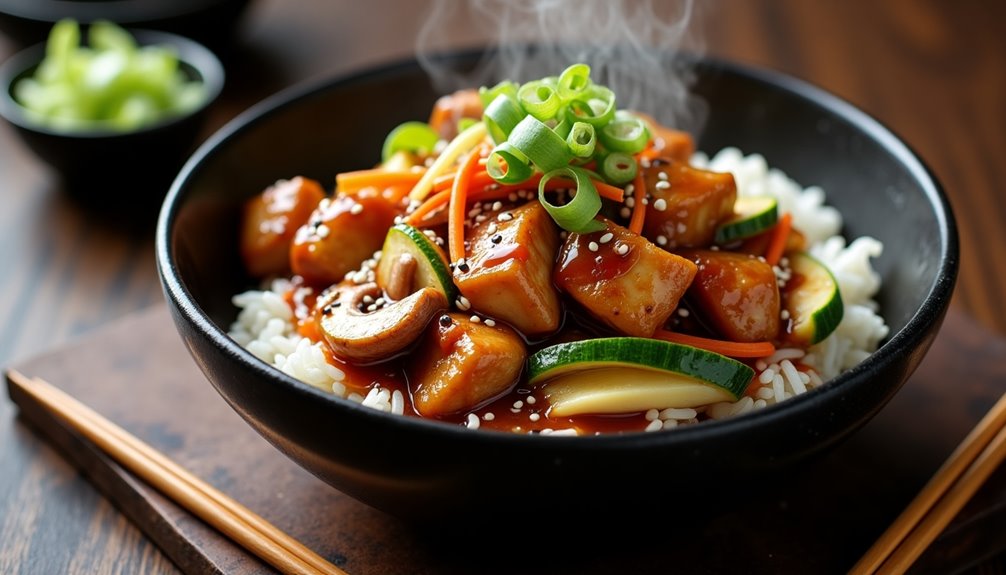
Teriyaki chicken hibachi bowls bring the exciting flavors of Japanese steakhouse cuisine right to your home kitchen. This simplified version captures the essence of hibachi-style cooking while using readily available ingredients and basic kitchen equipment instead of a traditional flat-top grill.
The combination of tender chicken, sautéed vegetables, and fluffy rice creates a satisfying meal that's both nutritious and flavorful. The homemade teriyaki sauce adds a perfect balance of sweet and savory elements that coat each component of the dish beautifully.
- 2 chicken breasts, cut into 1-inch cubes
- 2 cups jasmine rice
- 1 zucchini, sliced
- 1 onion, diced
- 2 carrots, julienned
- 8 mushrooms, sliced
- 4 tablespoons soy sauce
- 2 tablespoons mirin
- 2 tablespoons brown sugar
- 1 tablespoon cornstarch
- 2 tablespoons vegetable oil
- 2 cloves garlic, minced
- 1 tablespoon ginger, grated
- Salt and pepper to taste
- Sesame seeds for garnish
Start by cooking the rice according to package instructions. While the rice cooks, prepare the teriyaki sauce by combining soy sauce, mirin, brown sugar, and cornstarch in a small bowl. Heat oil in a large skillet over medium-high heat and cook the chicken pieces until golden brown and cooked through, about 5-7 minutes. Remove the chicken and set aside.
In the same pan, sauté the garlic and ginger until fragrant, then add the vegetables. Cook until the vegetables are tender-crisp, about 5 minutes. Return the chicken to the pan, pour in the teriyaki sauce, and cook until the sauce thickens and coats everything evenly. Serve over the prepared rice and garnish with sesame seeds.
For best results, ensure all ingredients are cut uniformly for even cooking, and have everything prepped before starting to cook. The key to achieving the signature hibachi flavor is cooking over high heat and moving quickly to prevent overcooking. You can customize the vegetable selection based on preferences or availability, and adjust the sauce's sweetness by modifying the amount of brown sugar used.


